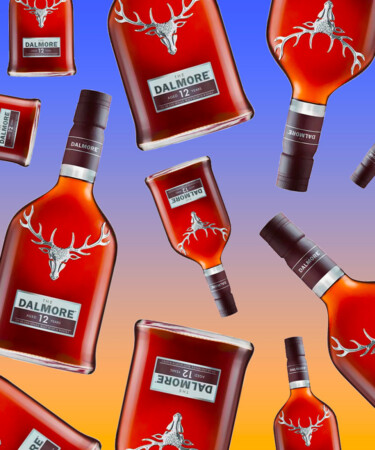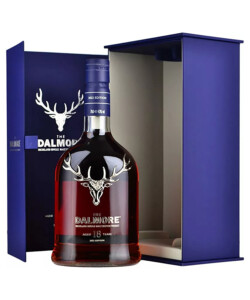Nestled on the banks of the Cromarty Firth in Alness, Scotland, is The Dalmore distillery, founded in 1839 by merchant adventurer Sir Alexander Matheson. The wealthy tradesman hoped to differentiate his distillery from others in Scotland by choosing the isolated location to produce predominantly single malt Scotch whisky — and it worked.
The distillery changed hands just a few decades after its founding, and quickly rose in popularity among Scotch drinkers who were accustomed to drinking blended whisky from other distilleries. Once synonymous with 12-year-old single malt whisky, The Dalmore now has nine Scotches in its principal collection and a handful of exploratory limited releases.
Now that you know the basics, here are nine more things you should know about The Dalmore.
-
The Dalmore’s founder built the entire distillery from scratch.
Matheson chose the land upon which The Dalmore currently resides for the supply of high-quality barley, peat, and water in the surrounding area. The land was originally home to a mill and a farm yard, and in 1839, Matheson quickly got to work converting the existing structure into a fully operational distillery. He designed and constructed everything himself, from the distilling buildings to the maturation warehouses and even the train lines used to connect the remote site to the outside world. The distillery grounds were also home to a pier, which allowed for steamer ships to transport in barley, coal, and casks for whisky production. Upon completion of the construction, Matheson leased the space to the Sunderland family, which operated the distillery until the late 1860s.
-
In 1867, the distillery was overtaken by descendants of Clan Mackenzie.
Twenty-eight years after the distillery’s founding, the lease was turned over to brothers Andrew and Charles Mackenzie, descendants of the storied Scottish clan that had close ties to the monarchy and a role in the Jacobite uprising. The brothers sought to expand The Dalmore’s presence both locally and beyond by upgrading the facilities and developing the network of contacts built up by Matheson during his travels. By utilizing these connections, the Mackenzie brothers were able to export their Scotch whisky to Australia and New Zealand by the 1870s, making them the first malt whisky brand to do so. Andrew, Charles, and their other brother William finally purchased the distillery from Sir Kenneth Matheson, Sir Alexander’s son, in 1891 after the passing of the 1886 Crofters Holdings Act, which declared crofters had the right to own their land for the first time in Scottish history.
-
The stag on every bottle of The Dalmore comes from a 13th-century legend.
One of the first orders of business for the Mackenzie brothers when they took control of the distillery was embossing every bottle of the whisky with a silver stag. The legend of the stag dates back to 1263 when the first chieftain of Clan Mackenzie, Colin of Kintail, saved the life of King Alexander III of Scotland while on a hunt. The story goes that while on the pursuit, a stag came charging at the king, only to be intercepted by the chieftain, who stabbed the beast and shouted “Cuidich ‘n’ Righ” or “save the king” in Gaelic. The monarchy granted Clan Mackenzie the right to bear a 12-point Royal Stag on their family crest, which would appear on The Dalmore’s bottles centuries later.
-
The distillery was used as a military headquarters in both world wars.
When World War I broke out, Scotland was forced to implement a number of food rations, and barley was no exception. The Dalmore was required to cease production and the distillery was commandeered as a base for the U.S. Navy in 1917. The space was used to construct and assemble explosive landmines, and once completed, the explosives were exported to the front lines via train, then loaded onto naval ships bound for the North Sea. The distillery was occupied by the Navy until 1920 and suffered immense damage over the course of the war, including a fire in the peat storage area that spread to several other buildings.
-
In the 1900s, The Dalmore struggled to stay afloat.
It took substantial repairs to restore the site to its former glory, and though Andrew’s son, William F. Mackenzie, was able to reopen the distillery, he was forced to shut its doors in 1926 due to a lack of funding. He resumed the operation a year later under the name Mackenzie Bros, Dalmore Ltd with the intention of selling the company. But unable to secure a buyer, The Dalmore ran at a loss for a year, and continued to struggle until the repeal of the 18th Amendment in 1933. The legalization of alcohol in the U.S. led to a brief production boom at the distillery, which allowed for new warehouses to be constructed to house the in-demand whisky. That success was short-lived: In 1939, The Dalmore was again forced to cease production as World War II began. The distillery was once more overtaken by the military, this time the Royal Air Force, which used the grounds as a headquarters. Distillation resumed once the war ended, and The Dalmore remained family-owned by the Mackenzies until 1960 when it merged with Whyte & Mackay, a beverage company that had been purchasing The Dalmore for years to use in its own blended Scotch whiskies.
-
The distilling team uses eight stills to produce its whisky.
At The Dalmore, four wash stills and four spirits stills are used during distillation, each of which has two different production capacities. The brand says that it is these varying production capacities that contribute to the robust and fruity flavor profile of the whisky, which is distilled with the express purpose of lengthy aging. Further contributing to the stills’ idiosyncratic nature is the unique shape of the stills themselves. The wash stills are each equipped with a constricting mechanism in the middle of the structure which results in higher levels of reflux during distillation, and thus higher concentration of flavor. And unlike standard spirit stills, The Dalmore’s spirit stills are flat on top. Legend says this is because once the distillery was fully built, the original stills did not fit into the building, and the tops needed to be removed to properly fit the stills. Rather than being attached to the top of the spirit stills as they typically would be, lyne arms were instead attached to the side, prompting increased copper contact, which results in more pronounced spice notes in the whisky.
-
Before 2002, The Dalmore only produced 12-year-old single malt.
The Dalmore 12 is the Scotch brand’s flagship release, and for over a century and a half, it remained the sole expression the distillery offered. All changed in 2002 when The Dalmore expanded on the decade-old offering with the release of The Dalmore 21, a 21-year-old single malt, and the Cigar Malt Reserve, both of which are still staples of the brand’s core portfolio. The Dalmore’s Principal Collection would follow, and includes The Dalmore 14, The Dalmore 15, and The Dalmore 18, as well as King Alexander III, Port Wine Reserve, and Sherry Cask Select 12.
-
The Dalmore’s limited releases contain two exploratory collections.
In addition to the Principal Collection, The Dalmore also offers five limited-release Scotch whiskies, each of which falls into two collections: Cask Curation and Luminary. The Cask Curation series contains three Scotches, each of which have been matured in ex-bourbon barrels and finished in three different types of sherry barrels: vintage sherry, Matusalem, and Apostoles. Rounding out the brand’s limited releases is the Luminary collection, which currently contains two distinct expressions: The Collectable Luminary No1 2022 Edition, and The Rare Luminary No1 2022 Edition.
The former, of which 15,000 bottles were produced, was matured in white American oak before finishing in Kintsugi casks, which are made from a combination of Scottish Tay oak, Japanese Mizunara oak, and American white oak. The Rare truly lives up to its name with only three bottles in existence. The 48-year-old single malt was aged in ex-bourbon casks and finished in a combination of Matusalem and Apostle oloroso sherry casks and vintage port pipes.
-
The Dalmore is renowned for its sherry and port wine maturation programs.
In the 1800s, The Dalmore’s original distillers began importing casks from Jerez, Spain (the sherry capital of the world) to Scotland, making The Dalmore the first in the Scotch industry to utilize what they referred to as “sherry wood.” The distillers eventually came to an exclusive agreement with sherry producer González Byass to supply them with barrels that were filled with sherry for 30 years — 10 times longer than average. After three decades spent in the cask, about 5 percent of the wine inside would be left behind, thus imparting a richer, more complex and velvety sherry essence on the whisky during finishing.
Given the prized nature of these barrels, they are reused time after time and are never disposed of unless they’re entirely beyond repair. To this day, The Dalmore remains the sole distillery in the Scotch whisky industry able to access casks from González Byass.

